Discovering Our Native Butterflies!

We visited Milkweed Meadows Farm in Fruitland, NC to observe all of the beautiful butterflies native to our region. Milkweed Meadows is owned and operated by Kim Bailey, an environmental educator and Bee City USA volunteer. The farmland has been in her husband’s family for generations and hosts thousands of pollinator-friendly plants. On her property, she grows plants that butterflies, hummingbirds, and bees love–like milkweed, pawpaw, and passionvine. Through plant sales, she raises money for Bee City USA – Hendersonville, a program dedicated to creating healthy habitats for pollinators. Read more about Kim Bailey and her milkweed meadows here.
Spicebush Swallowtail

First, Kim showed me her spicebush plant and encouraged me to take a closer look. I noticed its bright green leaves were scattered with water droplets and she held a leaf corner that had been curled over. I figured some plants do this, especially when they are in need of more water.
As she peeled the leaf back, a teeny tiny white and brown ‘slug’ was unfurled. She said it was a Spicebush Swallowtail caterpillar, and after closer inspection, I believed her. Although it was not very colorful and resembled a small, glossy worm, I realized that caterpillars too can come in all different shapes, colors, and sizes.
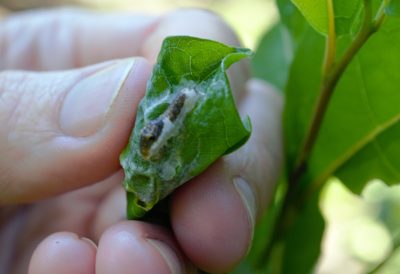
Caterpillars are masters of mimicry. In its larval stage, it has adapted to its environment by disguising itself as a bird dropping, which encourages predators to leave it be.
As it progresses into a larger caterpillar, it will change color to yellow and green and sport large false eyespots, alluding to the appearance of a common green snake. Imitating snakes helps caterpillars ward off predators, especially birds. And if that’s not impressive, they take it one step further by rearing up and retracting their head in true snake fashion.
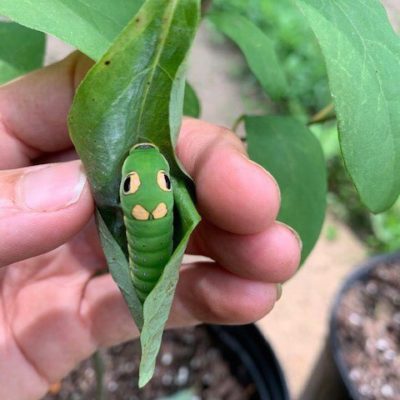
When deciding which leaf to lay their eggs on, female swallowtail butterflies will drum their forelegs on the leaf to decipher its chemical makeup. This helps to decide whether it is an acceptable leaf. While still larvae, spicebush swallowtails remain on the leaf they were laid on. In daylight, they reside in the shelter of the leaves to avoid predators and then emerge at night to feed on their host.
I would have walked right by this plant, not knowing it was spicebush and what type of life it could harbor. But once you learn each species’ characteristics, they are easier to discover in nature, and appreciating them outside in their natural environment helps you feel more connected.

Pipevine Swallowtail
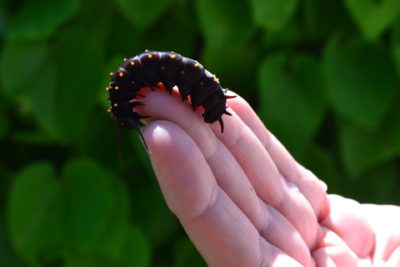
Kim then escorted me into her trellis tunnel covered with pipevines. We flipped and examined the leaves in search of caterpillars, looking for gentle nibbles on their shaded leaves. All of a sudden, Kim exclaimed, “Here’s one!” and asked if I’d like to hold it. She plopped it into my hands and it was the first time I’d ever held a caterpillar.
It was so much larger and more alien-looking than I expected! A little larger than my pinky finger, this caterpillar was completely black with long antennae, spikes, and orange spots lining its spine. As it shuffled across my palm looking for more pipevines to chomp, I felt its tiny hoof-like feet suctioning over my skin. A feeling I’d never felt before—this is what life feels like exploring the palm of your hands!

As newly hatched caterpillars, they are light to dark orange and the first thing they will do is eat their own eggshells before chewing on plant leaves. Most butterfly caterpillars are solitary eaters, but this species feeds in groups.
Although they are orange and black as mature caterpillars, they will emerge the chrysalis with striking colors. The surface of its wings are a showy metallic black and blue with white spots. On the underside when its wings are closed, you will get a glimpse of its striking orange spots.
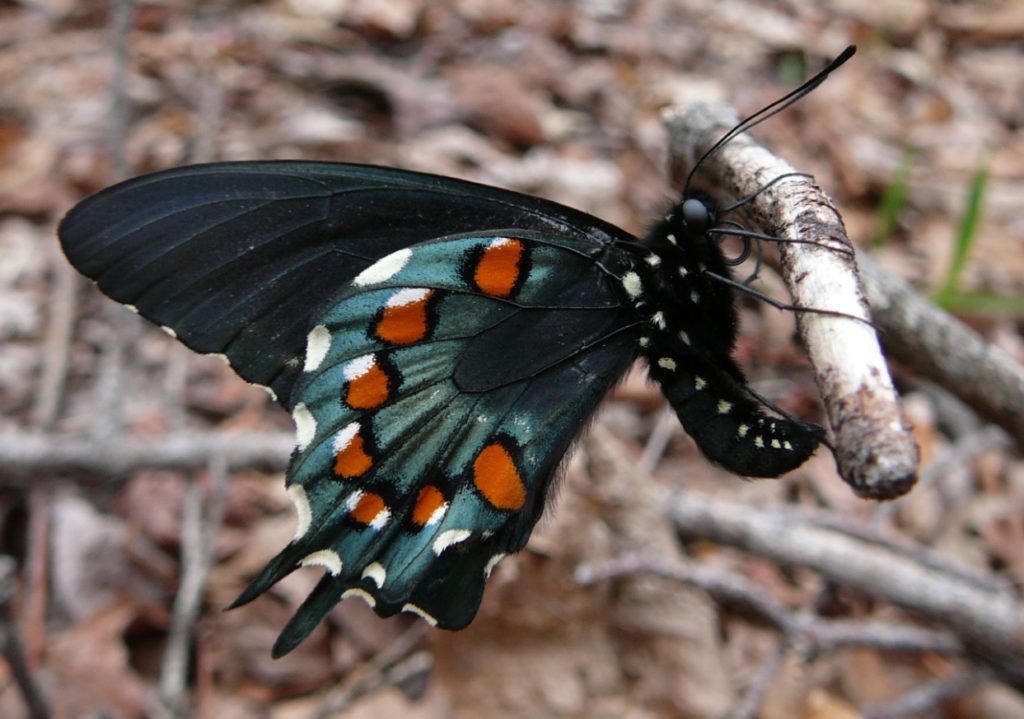
The Monarch

One of the most recognized butterflies in North America is the monarch. It accomplishes one of the most incredible feats in nature, traveling upwards of 3,000 miles from Canada and the northern United States, all the way to the mountains of central Mexico. Amazingly, millions of monarchs will return to the very oyamel fir trees their prior generations had roosted in long before they were born.
Monarchs are poisonous to birds, lizards, and mammals due to their milkweed-rich diets, since milkweed leaves are their only source of food as larvae.
Like I mentioned before, I would have walked right by this plant, and not ever known, or thought to consider, that there would be a chunky, lively caterpillar scaling its stem.
Seeing the monarch caterpillar parading the leaves of milkweed in real-time was a surreal experience. I couldn’t take my eyes away, and it reminded me of the smaller, less talked about life that benefits our ecosystem. These insects are so real—even if you don’t see them every day. They require such specific habitat and there is nothing more rewarding than observing life thriving in the nature you helped to preserve.
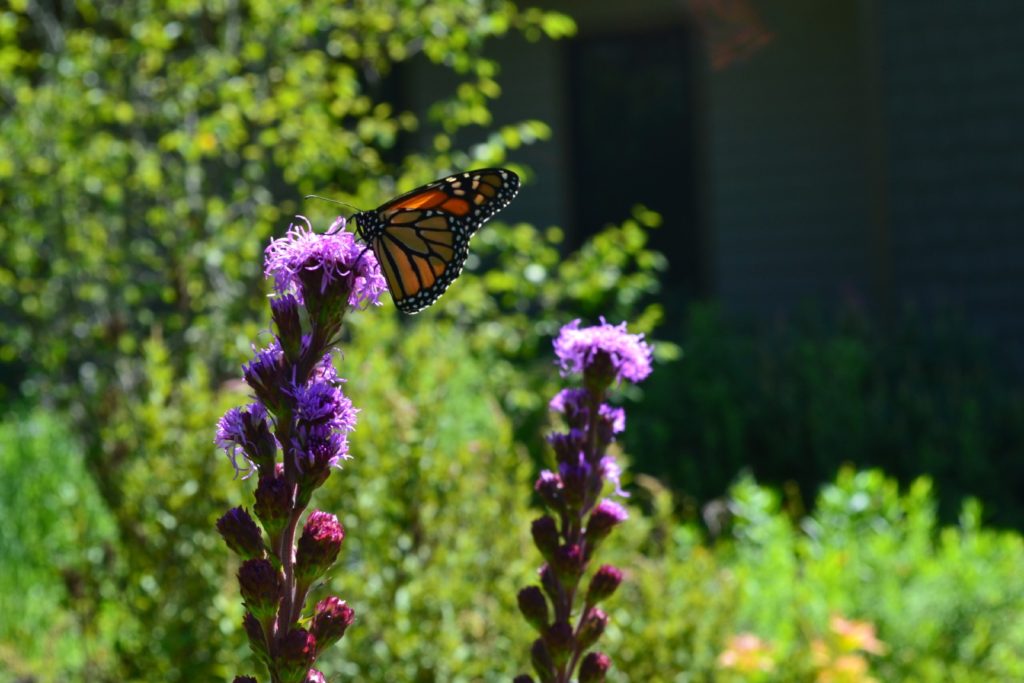
The Butterfly Effect
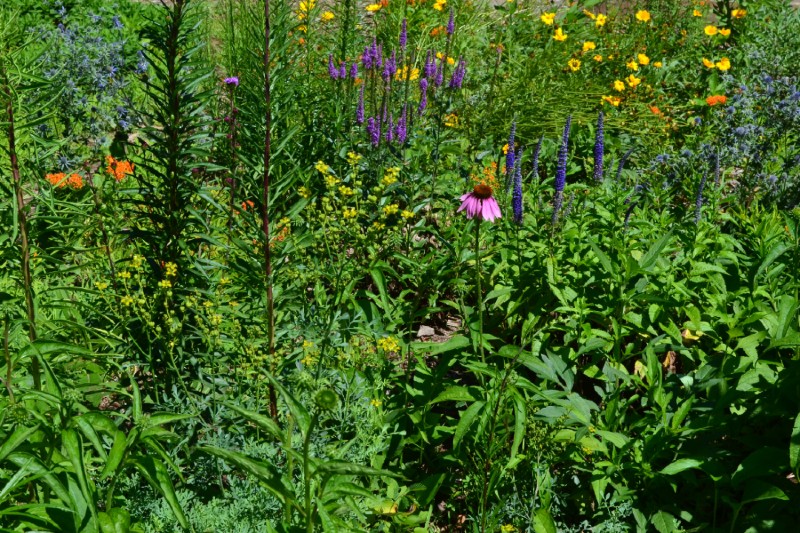
Growing up in my suburban backyard, I did not have many positive experiences with insects. I observed the occasional ant hill and spider web, dodged ants as I climbed my cherry tree, and even extracted too many pincher bugs from my sandbox. But I can finally say that now I’ve learned the true value of insects—from serving as water quality indicators in streams, to sustaining thousands of acres of crops. To ignore these essential critters is to ignore life. They are right in front of and below us, 9 times out of 10, 24/7, 365 days a year, and we may not even notice. Each and every insect, including these butterflies, play an important role in our ecosystem and we must take notice more often.
Written by AmeriCorps Communications and Education Associate Rachel Hess. Butterfly expertise provided by environmental educator and Bee City – Hendersonville volunteer Kim Bailey.